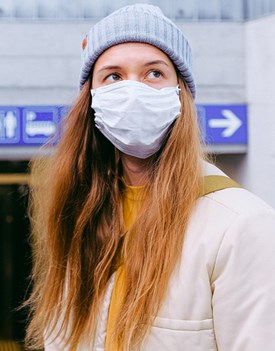20 October 2020
Guidance on Face Coverings for COVID-19
Information includes tips for preventing face coverings from irritating your psoriasis.
As part of the gradual changes in restrictions, people across the UK are being asked to wear a face covering (something which safely covers the nose and mouth) in certain places where social distancing is very difficult or not possible. However, the specific guidance varies in different parts of the UK. You can find links to the specific guidance for England, Northern Ireland, Scotland and Wales below. Each nation's guidance covers instances in which face coverings must be worn, as well as any exemptions.
Exemption card templates are available for people who have an age, health or disability reason for not wearing a face covering and may feel more comfortable showing something that states this. However, this is a personal choice and is not necessary in law.
Why are we being advised to wear a face covering?
While evidence suggests that face coverings will not protect you against COVID-19, when used correctly they may reduce the spread of coronavirus droplets in certain circumstances, helping to protect others if you are infected but do not know it. Because face coverings are mainly intended to protect others, not the wearer, they are not a replacement for social distancing and regular hand washing. If you have symptoms of COVID-19, you and your household must isolate at home: wearing a face covering does not change this.
Young children or individuals who find it difficult to wear face coverings, such as people with breathing difficulties or primary school children who cannot use a covering without help, are not advised to wear them.
Wearing a face covering
A face covering is something which safely covers the nose and mouth while allowing you to breathe comfortably. It should fit securely to the side of the face and be secured to the head with ties or ear loops. It should be made of a material that you find to be comfortable and breathable, such as cotton, and ideally include at least 2 layers of fabric.
You can buy reusable or single-use face coverings. You may also use a scarf, bandana, religious garment or hand-made cloth covering but these must securely fit round the side of the face. The government has provided advice on how to wear and make your own face covering, which can be found here.
When applying a face covering, it is important that you wash your hands first (or use hand sanitiser) and avoid touching your face. Once applied, you should avoid wearing it on your neck or forehead and avoid touching the part of the face covering in contact with your mouth and nose, as it could be contaminated with the virus.
After each use, you should wash or sanitise your hands before removing the covering, using only the straps, ties or ear loops, and put it in a plastic bag for washing or safe disposal. You should then wash or sanitise your hands again. If you plan to re-use the face covering, it should be washed in soap or detergent first, at the highest temperature appropriate for the fabric.
You can find more detailed instructions on how to wear and remove a face covering here.
Face coverings and psoriasis
If you feel that your face covering is irritating your psoriasis, you could try the following:
- Make sure that the covering is made of a breathable fabric that your skin can tolerate. As with many aspects of psoriasis, this may be a process of trial and error.
- Whilst the covering needs to be secure, make sure that it is not rubbing or causing injury to the skin as this could trigger psoriasis through Koebner’s phenomenon.
- Finding the right face covering to lessen irritation may be a process of trial and error. Some people may find wearing a scarf more comfortable if it is for short periods. Or, if you have psoriasis behind your ears it may help to use an extender or adapter to relieve the pressure and attach the covering behind the head. Alternatively, a face covering which ties around the back of the head may be helpful.
- Keep your skin clean and well moisturised.
- Wash the covering after each use with a detergent that doesn’t irritate your skin.
- Try to take regular breaks from wearing the face covering.
- Try to avoid wearing make up in the area under the face covering.
- If your psoriasis worsens speak to your doctor about your treatment options.
For further information and advice on scalp or facial psoriasis,
please do get in
contact with us.
Further information about COVID-19 for people with psoriasis and psoriatic arthritis can be found here.
Please note, this information was first published on 21st May 2020, and last updated on 20th October 2020.
